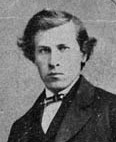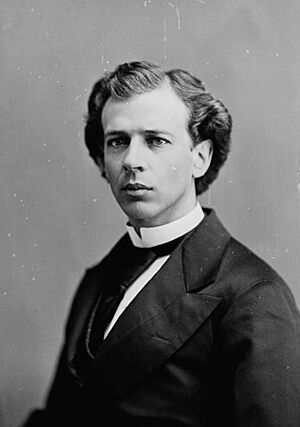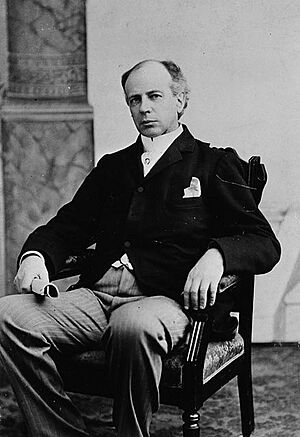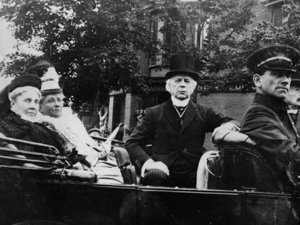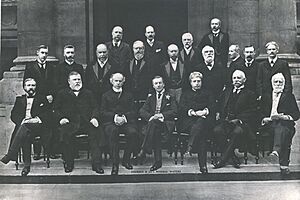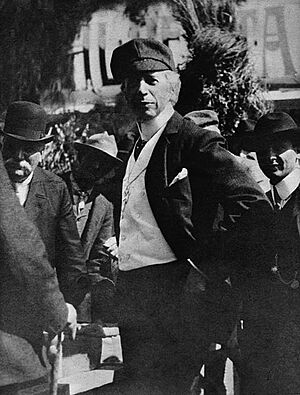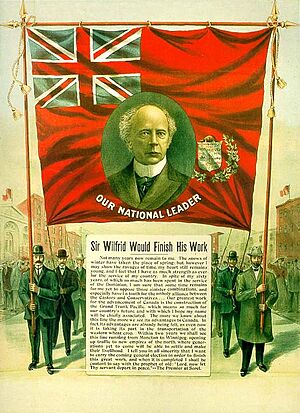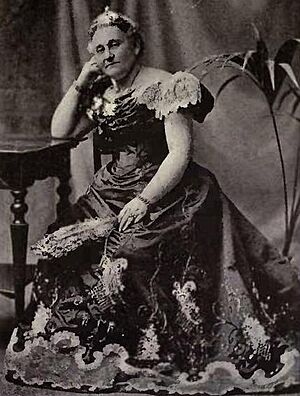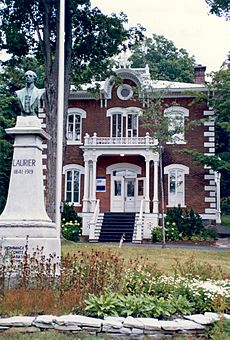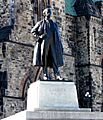Wilfrid Laurier facts for kids
Quick facts for kids
Wilfrid Laurier
|
|
|---|---|
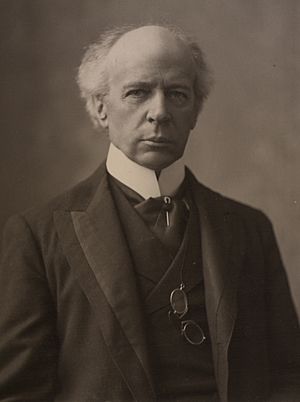
Laurier in 1906
|
|
| 7th Prime Minister of Canada | |
| In office July 11, 1896 – October 6, 1911 |
|
| Monarch | |
| Governor General |
|
| Preceded by | Charles Tupper |
| Succeeded by | Robert Borden |
| Leader of the Liberal Party | |
| In office June 2, 1887 – February 17, 1919 |
|
| Preceded by | Edward Blake |
| Succeeded by | Daniel Duncan McKenzie (interim) |
| Minister of Inland Revenue | |
| In office October 8, 1877 – October 8, 1878 |
|
| Preceded by | Joseph-Édouard Cauchon |
| Succeeded by | Louis François Georges Baby |
| Member of Parliament for Quebec East |
|
| In office November 11, 1877 – February 17, 1919 |
|
| Preceded by | Isidore Thibaudeau |
| Succeeded by | Ernest Lapointe |
| Member of Parliament for Drummond—Arthabaska |
|
| In office January 22, 1874 – October 27, 1877 |
|
| Preceded by | Pierre-Nérée Dorion |
| Succeeded by | Désiré Olivier Bourbeau |
| Member of the Legislative Assembly of Quebec for Drummond-Arthabaska | |
| In office July 1871 – January 22, 1874 |
|
| Preceded by | Edward John Hemming |
| Succeeded by | William John Watts |
| Personal details | |
| Born |
Henri Charles Wilfrid Laurier
20 November 1841 Saint-Lin, Canada East |
| Died | 17 February 1919 (aged 77) Ottawa, Ontario, Canada |
| Resting place | Notre Dame Cemetery, Ottawa, Ontario |
| Political party | Liberal |
| Other political affiliations |
Laurier Liberal (1917–1919) |
| Spouse |
Zoé Lafontaine
(m. 1868) |
| Education | McGill University (LL.L., 1864) |
| Profession | Lawyer |
| Signature | |
Sir Wilfrid Laurier (born November 20, 1841 – died February 17, 1919) was a Canadian lawyer and politician. He served as the seventh prime minister of Canada from 1896 to 1911. He was the first French Canadian prime minister. His 15 years in office is the longest time any Canadian prime minister has served without a break. He also spent almost 45 years in the House of Commons, which is a record. Laurier is famous for finding ways to bring together English and French Canadians.
Laurier studied law at McGill University and worked as a lawyer. He was elected to the Legislative Assembly of Quebec in 1871. Then, he became a Member of Parliament (MP) in 1874. As an MP, Laurier became very popular with French Canadians. He was also known as a great speaker. From 1877 to 1878, he was the Minister of Inland Revenue under Prime Minister Alexander Mackenzie. In 1887, Laurier became the leader of the Liberal Party. This made him the leader of the Official Opposition. He lost the 1891 election to Prime Minister John A. Macdonald's Conservatives.
However, a problem called the Manitoba Schools Question helped Laurier win the 1896 election. This problem started when the Manitoba government stopped funding Catholic schools. As prime minister, Laurier solved this by allowing Catholic students to have Catholic education in some schools. Even though some French Canadians thought this was not enough, he was called "the Great Conciliator" for finding a compromise.
Canada faced big decisions about supporting the British Empire. English Canadians often wanted to help Britain, while French Canadians did not. Laurier's government tried to find a middle ground. They sent a volunteer force to the Second Boer War. They also created Canada's own navy with the 1910 Naval Service Act. Laurier's government also brought many new people to Canada. They helped Alberta and Saskatchewan become provinces. They built new railways and worked to make Canada more independent within the British Empire.
In 1911, Laurier suggested a trade deal with the United States to lower taxes on goods. This idea became a major issue in the 1911 election. The Liberals lost to the Conservatives, led by Robert Borden. Borden argued that the trade deal would make Canada too much like the US. Even after losing, Laurier stayed on as Liberal leader. During World War I, he faced challenges when some Liberals joined Borden's government to support conscription (forced military service). Laurier was against conscription and led the "Laurier Liberals" who opposed it. They lost the 1917 election. Laurier died in 1919 while still leading the Opposition. He is considered one of Canada's top prime ministers.
Contents
Early Life and Education (1841–1871)
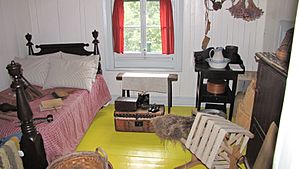
Childhood and School Days
Henri Charles Wilfrid Laurier was born on November 20, 1841. He was born in Saint-Lin, Canada East (now Saint-Lin–Laurentides, Quebec). His family had lived in Canada for six generations. His father was a farmer and surveyor. He was also the mayor, a judge, and a school board member.
When Wilfrid was 11, he went to school in New Glasgow, a village with many Scottish immigrants. For two years, he learned English and about British culture. In 1854, Laurier went to Collège de L'Assomption. This school was very strict about Roman Catholicism. Here, he became interested in politics. He started to support liberalism, even though the school was very conservative.
Starting in Politics
In September 1861, Laurier began studying law at McGill University. There, he met Zoé Lafontaine, who would become his wife. He also found out he had chronic bronchitis, a lung illness that lasted his whole life. At McGill, Laurier joined the Parti Rouge, or Red Party. This was a political party in Canada East that wanted changes.
Laurier graduated from McGill in 1864. He stayed active in the Parti Rouge. From 1864 to 1866, he was vice president of the Institut canadien de Montréal. This was a literary group linked to the Rouge party. In August 1864, Laurier joined the Liberals of Lower Canada. This group was against Confederation. They believed Confederation would give too much power to the central government. They also thought it would lead to unfair treatment of French Canadians.
Laurier then worked as a lawyer in Montreal. At first, he struggled to find clients. He opened his first office in October 1864 but closed it within a month. His second office closed in three months. In March 1865, Laurier partnered with Médéric Lanctot, a lawyer and journalist. Lanctot was strongly against Confederation. They had some success. In late 1866, Laurier became the editor of the newspaper Le Défricheur.
Laurier moved to Victoriaville and started writing for the newspaper in 1867. He used the paper to share his strong views against Confederation. He wrote that Confederation would make French Canadians too much like the English. He said they needed their own government. On March 21, Le Défricheur closed due to money problems and opposition from the local church. On July 1, Confederation officially began. This was a defeat for Laurier.
Laurier stayed in Victoriaville. He became well known in the town. He was even elected mayor. He also started a law practice that lasted for 30 years. During this time, Laurier decided to accept Confederation. He became a moderate liberal, not a radical one.
Early Political Career (1871–1887)
Provincial Politics in Quebec (1871–1874)
Laurier was a member of the Quebec Liberal Party. He was elected to the Legislative Assembly of Quebec in 1871. He represented the area of Drummond-Arthabaska. The Liberal Party lost badly in that election. Laurier promised to increase money for education, farming, and settlement. He did not speak much in the legislature during his time there.
Becoming a Member of Parliament (1874–1887)
Laurier left the provincial government to join federal politics. He was elected to the House of Commons in the 1874 election. He represented the area of Drummond—Arthabaska. In this election, the Liberals, led by Alexander Mackenzie, won a big victory. This was because of the Pacific Scandal involving the Conservative Party and Prime Minister John A. Macdonald. Laurier campaigned against Conservative corruption.
As an MP, Laurier wanted to become well known by giving speeches. He gained a lot of attention on June 26, 1877. He gave a speech about political liberalism to about 2,000 people. He said that the Liberal Party was not dangerous. He stated that the Liberals wanted to protect Canada's institutions. They also wanted to develop the country's resources. This speech helped Laurier become a leader of the Liberal Party in Quebec.
From October 1877 to October 1878, Laurier was briefly in the Cabinet. He served as Minister of Inland Revenue under Prime Minister Mackenzie. His appointment meant a special election was held on October 27, 1877. He lost his seat in Drummond—Arthabaska. On November 11, he ran for the seat of Quebec East, which he won. Laurier held the Quebec East seat until his death in 1919.
Laurier won re-election for Quebec East in the 1878 election. However, the Liberals lost badly. This was because they handled the economy poorly after the Panic of 1873. Macdonald became prime minister again.
Laurier asked Mackenzie to resign as leader. Mackenzie resigned in 1880, and Edward Blake took over. Laurier helped start a Quebec newspaper, L’Électeur, to support the Liberal Party. The Liberals were in opposition again. Laurier spoke about his support for free markets and provincial rights. The Liberals lost again in 1882. Macdonald won his fourth term. Laurier continued to speak against the Conservative government. In 1885, he spoke out against the hanging of Louis Riel. Riel was a Métis leader who was executed by Macdonald's government after the North-West Rebellion.
Leading the Opposition (1887–1896)
Edward Blake resigned as Liberal leader after losing two elections. Blake asked Laurier to become the new leader. At first, Laurier did not want such a powerful job, but he later accepted. After 13 years, Laurier was already a well-known politician. He was known for leading the Quebec Liberals. He was also known for defending French Canadian rights and for being a great speaker. Over the next nine years, Laurier slowly made his party stronger across Canada.
In the 1891 election, Laurier faced Conservative Prime Minister John A. Macdonald. Laurier wanted reciprocity, or free trade, with the United States. Macdonald was against this. He said it would lead to the US taking over Canada. On election day, March 5, the Liberals gained 10 seats. They also won most seats in Quebec for the first time since 1874. Prime Minister Macdonald won his fourth election in a row.
Laurier felt discouraged after his defeat. He often thought about resigning as leader, but other Liberals convinced him to stay. In 1893, Laurier felt hopeful again. On June 20 and 21, 1893, Laurier held a Liberal meeting in Ottawa. The meeting decided that free trade would help Canada's natural resources. It also said that customs taxes were needed to make money. Laurier then went on speaking tours to promote these ideas. He visited Western Canada in 1894. He promised to change Conservative policies, open the American market, and increase immigration.
Macdonald died just three months after winning the 1891 election. After his death, the Conservatives had a difficult time. They had four different leaders in a short period. Charles Tupper became prime minister in May 1896. This happened after Mackenzie Bowell resigned because of problems with the Manitoba Schools Question. This problem started when Manitoba stopped funding Catholic schools in 1890.
Tupper faced Laurier in the 1896 election. The schools dispute was a key issue. Tupper wanted to force Manitoba to fund Catholic schools again. Laurier was less clear. He suggested investigating the issue first and then finding a compromise. He called this approach "sunny ways." On June 23, Laurier led the Liberals to their first victory in 22 years. His win was largely due to his strong support in Quebec.
Prime Minister of Canada (1896–1911)
Policies at Home
Manitoba Schools Question
One of Laurier's first actions as prime minister was to solve the Manitoba Schools Question. This problem had caused the fall of the previous Conservative government. The Manitoba government had stopped public funding for Catholic schools. Supporters of Catholic schools said this went against the Manitoba Act, 1870. But the courts said the new law was legal. The Catholic minority in Manitoba asked the federal government for help. The Conservatives had suggested a law to force Manitoba to change its rules. Laurier was against this because he believed in provincial rights. He managed to stop the law from passing.
Once elected, Laurier made a deal with Manitoba's premier, Thomas Greenway. This deal, called the Laurier-Greenway Compromise, did not bring back separate Catholic schools. However, Catholic teaching could happen for 30 minutes at the end of each day. This was allowed if enough parents asked for it. Catholic teachers could also be hired if there were enough Catholic students. Teachers could speak French if there were enough French-speaking students. Many saw this as the best solution. But some French Canadians criticized it. They felt it did not fully protect Catholic or French rights in all schools. Laurier called his way of solving this problem "sunny ways."
Building Railways
Laurier's government started the idea of building a second transcontinental railway. This was the Grand Trunk Pacific Railway. The first railway, the Canadian Pacific Railway, had limits. It could not meet everyone's needs. In the West, it could not move all the crops farmers grew. In the East, it did not reach Northern Ontario and Northern Quebec. Laurier wanted a railway built by private companies. He wanted it to be entirely on Canadian land.
Laurier's government also built a third railway, the National Transcontinental Railway. This railway was meant to connect Western Canada directly to the Atlantic ports. It also aimed to open up and develop Northern Ontario and Northern Quebec. Laurier believed that competition between the three railways would make them lower prices. This would help Western farmers.
Laurier's government made a deal with the Grand Trunk Pacific Railway Company. The company would build the western part (from Winnipeg to the Pacific Ocean). The government would build the eastern part (from Winnipeg to Moncton). Once finished, the government would give the railway to the company to run. People criticized Laurier's government because the railway was very expensive to build.
New Provinces and Borders
On September 1, 1905, Laurier oversaw Alberta and Saskatchewan joining Confederation. They were the last two provinces created from the Northwest Territories. Laurier decided to create two provinces. He thought one large province would be too hard to govern. Before this, in 1898, Laurier's government had created the Yukon Territory. Also in 1898, Quebec's size was increased.
Immigration
Laurier's government greatly increased immigration to help the economy grow. Between 1897 and 1914, over a million immigrants came to Canada. Canada's population grew by 40 percent. Laurier's immigration policy focused on the Prairies. He believed it would increase farming and help the agriculture industry.
People in British Columbia were worried about immigrants from Asia. They wanted a "whites-only" policy. Even though railways wanted to hire Asian workers, labor unions and the public were against it. Laurier's government supported policies that limited immigration from China and India. For example, in 1900, Laurier raised the Chinese head tax to $100. In 1903, it was raised to $500. He even suggested raising it to $1,000. Laurier also worked to limit Japanese immigration to Canada.
In August 1911, Laurier approved an order that aimed to keep out Black Americans. The order said that "the Negro race...is deemed unsuitable to the climate and requirements of Canada." This order was never fully used because other efforts had already reduced Black migration. It was cancelled on October 5, 1911, the day before Laurier left office.
Social Policies
In March 1906, Laurier's government passed the Lord's Day Act. This law became active on March 1, 1907. It stopped most business, work, and recreation on Sundays. Labor unions and the French Canadian Catholic Church supported it. But people in manufacturing and transportation were against it. French Canadians also opposed it because they felt the federal government was interfering in provincial matters.
In 1907, Laurier's government passed the Industrial Disputes Investigation Act. This law required employers and workers to try to find a solution before a strike in public services or mines. However, they did not have to agree to the solution.
In 1908, a system was started where people could buy annuities from the government. This was to help people save for old age.
Foreign Policy
Relations with the United Kingdom
On June 22, 1897, Laurier attended Queen Victoria's Diamond Jubilee. This was the 60th anniversary of her becoming queen. There, he was knighted and received many honors. Laurier visited the United Kingdom again in 1902. He took part in the 1902 Colonial Conference and the coronation of King Edward VII. Laurier also attended Imperial Conferences in 1907 and 1911.
In 1899, the United Kingdom wanted military help from Canada for the Second Boer War. Laurier was caught between English Canadians who wanted to help and French Canadians who strongly opposed it. French Canadians saw it as an "English war." Laurier decided to send a volunteer force, not a forced military draft. About 7,000 Canadian soldiers joined. Henri Bourassa, a strong French Canadian nationalist, was against any military help. He resigned from the Liberal Party in October 1899.
On June 1, 1909, Laurier's government created the Department of External Affairs. This allowed Canada to have more control over its foreign policy.
The United Kingdom and Germany were building up their navies in the early 1900s. Britain asked Canada for more money and ships. This caused a big debate in Canada. Many English Canadians wanted to send as much help as possible. Many French Canadians wanted to send nothing. Laurier tried to find a compromise. He passed the Naval Service Act in 1910, which created the Royal Canadian Navy. This navy would have five cruisers and six destroyers. In times of crisis, it could help the British Royal Navy. However, this idea was still opposed by some in both English and French Canada.
Alaska Boundary Dispute
In 1897 and 1898, the border between Alaska and Canada became a big issue. The Klondike Gold Rush made Laurier want an all-Canadian route from the gold fields to the sea. Laurier also wanted to know who owned the Lynn Canal and controlled access to the Yukon. Laurier and US President William McKinley agreed to set up a joint commission. This group would study and solve the dispute. However, this commission failed in February 1899.
The dispute then went to an international judicial commission in 1903. This group included three Americans, two Canadians, and one Briton. On October 20, 1903, the commission decided to support the American claims. Canada only got two small islands. This decision made many Canadians angry at both the US and Britain. Laurier briefly encouraged this anger.
Trade and Tariffs
Laurier supported free trade with the United States. But he did not pursue it because the American government refused to discuss it. Instead, he used a Liberal version of the Conservatives' National Policy. This policy kept high taxes on goods from countries that limited Canadian goods. However, he lowered taxes for countries that allowed Canadian goods in easily.
In 1897, Laurier's government lowered taxes by 12.5 percent for countries that imported Canadian goods at a fair rate. Taxes stayed the same for countries that put high taxes on Canadian goods. Most people supported this policy.
Laurier's government changed taxes again in 1907. They created a "three-column tariff." This added a new middle tax rate. The existing British preferential rate and the general rate stayed the same. The middle rates were slightly lower than the general rates.
Also in 1907, Laurier's finance minister, William Stevens Fielding, and minister of marine and fisheries, Louis-Philippe Brodeur, made a trade deal with France. This deal lowered import taxes on some goods. In 1909, Fielding made a deal to improve trade with the British West Indies.
Election Victories
Laurier led the Liberals to win three more elections: in 1900, 1904, and 1908. In 1900 and 1904, the Liberals gained more votes and seats. In 1908, their votes and seats went down slightly.
Quebec Support
By the late 1900s, Laurier had built strong support for the Liberal Party in Quebec. Quebec had been a Conservative stronghold for many years. This was because of its social conservatism and the influence of the Roman Catholic Church. The Church did not trust the Liberals. But French Canadians started to feel less connected to the Conservative Party. This was because the Conservatives were linked to anti-French groups in English Canada. These factors helped Laurier build strong support in French Canada and among Catholics. However, Catholic priests in Quebec often told their church members not to vote Liberal. Their slogan was "heaven is blue, hell is red," referring to the Conservative and Liberal party colors.
Trade Deal and Defeat
In 1911, there was a big debate about Laurier's support for trade reciprocity with the United States. His finance minister, William Stevens Fielding, made a deal for free trade of natural products. This deal would also lower tariffs (taxes on goods). Farmers, especially in Western Canada, strongly supported this. But many business people, who were a big part of the Liberal Party, were against it.
The Conservatives spoke out against the deal. They played on old fears that reciprocity could weaken ties with Britain. They also said it would make Canada's economy controlled by the United States. They argued it would make Canada lose its identity and be taken over by the US.
Laurier faced a difficult House of Commons, with strong disagreement from some Liberals. He called an election in 1911 to decide the issue of reciprocity. The Conservatives won, and the Liberals lost more than a third of their seats. The Conservative leader, Robert Borden, became prime minister. This ended over 15 years of Liberal rule.
Opposition and War (1911–1919)
Laurier stayed on as Liberal leader. In December 1912, he led the fight against the Conservatives' naval bill. This bill would have sent $35 million directly to the British Navy. Laurier argued that this would harm Canada's independence. After six months, the Liberal-controlled Senate blocked the bill.
Laurier led the opposition during World War I. He supported sending volunteers to fight in the war. He believed that a strong campaign for volunteers would get enough troops. Prime Minister Borden first used a volunteer system. But when fewer people volunteered, he brought in conscription (forced military service) in 1917. This led to the Conscription Crisis of 1917. Laurier was a strong opponent of conscription. French Canadians, who were generally against conscription, praised his stance.
Some Liberals, especially from English Canada, supported conscription. They joined Borden to form the Union government. Laurier refused to join this party. Instead, he created the "Laurier Liberals," made up of Liberals who opposed conscription. Laurier also turned down Borden's offer to form a coalition government (a government with both Conservatives and Liberals). He argued that there would be no "real" opposition to the government. He also worried that if the Liberals joined, Quebec would feel left out. He feared this would lead to Quebec being influenced by Henri Bourassa's "dangerous nationalism," which might cause Quebec to leave Canada.
In the 1917 election, the Laurier Liberals won very few seats outside Quebec. Laurier won almost all seats in Quebec (62 out of 65). This was largely because French Canadians respected and supported him for opposing conscription.
The Conscription Crisis showed the differences between French and English Canadians. Most English Canadians wanted conscription to strengthen ties with the British Empire. Most French Canadians opposed it because they did not want to be involved in the war. Laurier was seen as a "traitor" by English Canadians and English Canadian Liberals. But he was seen as a "hero" by French Canadians. Laurier's student and future party leader, William Lyon Mackenzie King, brought the English and French parts of the Liberal Party back together. He led them to victory in the 1921 election.
After the 1917 election, Laurier remained Liberal and Opposition leader. When World War I ended on November 11, 1918, he focused on rebuilding and reuniting the Liberal Party.
Death
Laurier died of a stroke on February 17, 1919. He was still the leader of the Opposition. Even though he had lost a difficult election two years earlier, people across Canada loved him. They remembered his "warm smile, his sense of style, and his 'sunny ways'." Between 50,000 and 100,000 people filled the streets of Ottawa for his funeral. He was buried at Notre Dame Cemetery. His remains were later placed in a stone tomb with sculptures of nine mourning women, representing the provinces. His wife, Zoé Laurier, died in 1921 and was buried in the same tomb.
Laurier was permanently replaced as Liberal leader by his former Minister of Labour, William Lyon Mackenzie King. King narrowly defeated Laurier's former Minister of Finance, William Stevens Fielding. Zoé Laurier said that Laurier wanted Fielding to be the next leader. He believed Fielding had the best chance to unite the party.
Personal Life
Wilfrid Laurier married Zoé Lafontaine in Montreal on May 13, 1868. She was born in Montreal and went to school there. The couple lived in Arthabaskaville until they moved to Ottawa in 1896. Zoé was a vice president of the National Council of Women. She was also an honorary vice president of the Victorian Order of Nurses. Wilfrid and Zoé Laurier did not have any children.
For about 20 years, starting in 1878, Laurier had a close friendship with a married woman named Émilie Barthe. Zoé was not interested in intellectual topics, but Émilie was. She loved literature and politics, like Wilfrid. There were rumors that he had a son with her, Armand Lavergne. But Zoé stayed with him until he died.
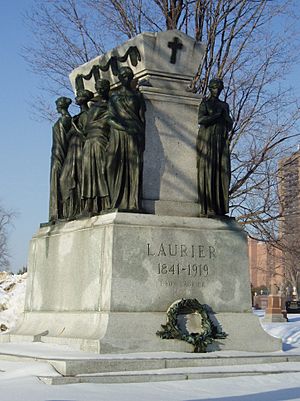
Legacy
Laurier's efforts to stay neutral between English and French Canadians are a big part of his legacy. He tried to find a middle ground between the two groups. This has led him to be ranked among the top three Canadian prime ministers. Even though he was French Canadian, he did not fully agree with all French Canadian demands. For example, he did not completely reverse Manitoba's ban on public funding for Catholic schools. He also did not refuse to send any Canadian troops to the Boer War.
However, in all seven elections he fought, most of Quebec's voting areas supported his Liberal Party. The Liberal Party continued to be very strong in Quebec federal politics until 1984.
Historian Jacques Monet wrote that Laurier was a "charismatic hero." His time in office was a happy period in Canadian history. He worked his whole life for cooperation between French and English-speaking Canadians. He also tried to keep Canada as independent as possible from Britain. His personal charm, dignity, and great speaking skills won the admiration of many people.
According to historians Norman Hillmer and Stephen Azzi, a 2011 survey ranked Laurier as the "best" Canadian prime minister. He was ranked ahead of John A. Macdonald and Mackenzie King. Historian Tim Cook said, "Sir Wilfrid was the full package." He was passionate, charming, and smart in both English and French.
Recognition
National Historic Sites
Laurier is remembered at three National Historic Sites.
The Sir Wilfrid Laurier National Historic Site is in his birthplace, Saint-Lin–Laurentides, Quebec. This site was created to honor his birthplace and early life.
Laurier's brick home in Ottawa is called Laurier House National Historic Site. It is at the corner of Laurier Avenue and Chapel Street. The Lauriers left the house to Prime Minister Mackenzie King in their will. King then gave it to Canada. Both sites are managed by Parks Canada.
The Lauriers' home from 1876 in Victoriaville, Quebec, is called Wilfrid Laurier House National Historic Site. It is privately owned and run as the Laurier Museum.
In November 2011, Wilfrid Laurier University in Waterloo, Ontario, revealed a statue. It shows a young Wilfrid Laurier sitting on a bench, thinking.
Other Honours
Laurier received many honors:
- He was called "The Honourable" and "PC" for life when he joined the Queen's Privy Council for Canada in 1877.
- He was called "The Right Honourable" when he joined the Imperial Privy Council of the United Kingdom in 1897.
- He was given the title "Sir" and "GCMG" as a knight grand cross of the Order of Saint Michael and Saint George in 1897.
- He received an honorary degree from the University of Edinburgh in 1902.
- Sir Wilfrid Laurier Day is celebrated every year on November 20, his birthday.
- Laurier is shown on several Canadian banknotes:
- The $1,000 note in the 1935 and 1937 series.
- The $5 note in the Scenes of Canada series (1972, 1979), Birds of Canada series (1986), Journey series (2002), and Frontier series (2013).
- Laurier has appeared on at least three postage stamps (1927, 1973).
Many places and landmarks are named after Laurier:
- Mount Sir Wilfrid Laurier, the highest peak in British Columbia's Premier Range.
- Sir Wilfrid Laurier Elementary School in Vancouver, British Columbia.
- Laurier Avenue in Milton, Ontario.
- Avenue Laurier in Shawinigan, Quebec.
- Laurier Boulevard and Laurier Hill in Brockville, Ontario.
- Avenue Laurier in Montreal, Quebec.
- Boulevard Laurier in Quebec City, Quebec.
- Laurier Avenue in Ottawa, Ontario.
- Laurier Avenue in Deep River, Ontario.
- Laurier Street in North Bay, Ontario.
- Rue Laurier in Casselman, Ontario.
- Rue Laurier Street in Rockland, Ontario.
- The Laurier Heights neighbourhood, including Laurier Drive and Laurier Heights School, in Edmonton, Alberta.
- Laurier Drive in Saskatoon's Confederation Park neighbourhood.
- The provincial voting area of Laurier-Dorion.
- The federal voting area of Laurier—Sainte-Marie.
- On November 1, 1973, Waterloo Lutheran University in Waterloo, Ontario, was renamed Wilfrid Laurier University.
- A Montreal Metro station, Laurier (Montreal Metro).
- CCGS Sir Wilfrid Laurier, a Canadian Coast Guard ship.
- Château Laurier, a famous hotel in downtown Ottawa.
- Sir Wilfrid Laurier Public School in Markham, Ontario.
- Sir Wilfrid Laurier School Board, an English school board in Quebec.
- Sir Wilfrid Laurier Secondary School in London, Ontario.
- Sir Wilfrid Laurier Secondary School in Ottawa, Ontario.
- Sir Wilfrid Laurier Collegiate Institute in Scarborough, Ontario.
Images for kids
See also
 In Spanish: Wilfrid Laurier para niños
In Spanish: Wilfrid Laurier para niños


